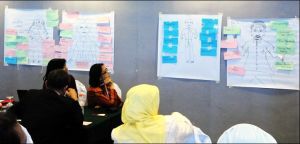
Participants at the ASEM gender in aquaculture training course, 2012 contemplate the basics. Source: Jariah Masud.
More development research institute leaders, researchers and project developers are aware of the importance of gender equality in programs and project activities. Some have made public commitments to action through their work. Often, however, these good intentions are thwarted by lack of knowledge and expertise on how to go about it. Of course, in an ideal world, the solution is to call in the experts, and this is still important. However, experts are much in demand and may not be readily accessible. How can you educate yourself about research and project development methods? One way is to learn from what the experts have written, of course!
This post highlights some condensed wisdom that has recently been published, plus provides links to some of our previous posts on gender research and development methods. If you know of other handy materials, we would welcome learning of them, so that we can help share them with our readers
Standards for collecting sex-disaggregated data
Visit this site to download the document
This 6 page guide is an excellent condensation of the key points, highlighted in the list of “MUST HAVES FOR GENDER ANALYSIS.” It is published by IFPRI on behalf of the CGIAR Policies, Institutions and Markets research program.
- Collect information about both men and women. Ask questions about specific individuals or groups and identify them by sex.
- Collect information from men and women. This does not necessarily require interviewing men and women in the same household. Studies that fail to include male and female respondents will be subject to biases; the extent of the bias will depend on the knowledge and perceptions of the respondent(s).
- All data collection methods must be context specific. Questions must be adapted to the context. Those collecting and analyzing the data need to understand gender roles and social dynamics. This knowledge must also guide the settings for interviews or focus groups.
- Budget for the additional costs of collecting sex-disaggregated data.
- Work with a gender expert early in the process to define the research question and methodology.
- Researchers collecting data from human subjects must ensure that the participants have completed a confidentiality and consent agreement. While these requirements are important for all research, they are essential for gender analyses that address sensitive topics such as asset ownership and domestic violence.
- Comparing male and female headed households is not gender analysis. Differences between these diverse household types cannot necessarily be attributed to the sex of the household head.
Value chain analysis and gender
This publication, Review of gender and value chain analysis, development and evaluation toolkits, from ILRI on behalf of the CGIAR research program on Livestock and Fish, is essentially a review of qualitative and quantitative tools found in workshop materials, manuals, guide books, handbooks, reports, research papers and toolkits themselves. It also gives sample rapid assessment tools for livestock and crop value chains.
Visit this site to download the publication
other resources from previous genderaquafish posts
We have posted in the past on a number of other research and project development resources. Here are their links.
1. From the FAO-Spain Regional Fisheries Livelhioods Programme
How to mainstream gender in small scale fisheries
RFLP Gender Mainstreaming manual
2. IFPRI on gender data in agriculture
Data needs for gender analysis in agriculture
This entry was posted in: Gender, Men, Women
